I had been quite active in the Flickr for many years, most of my work in Flickr is portraiture of insects and spiders, occasionally they fall outside this classification, one such instance is Harvestmen, which is considered a rare find for me. Flickr is a great place to learn and foster a certain spiritual relationship with people having the same interest. We encourage each other and share our views. I had learned from the many pictures that were taken by different wonderful photographers. Through their images I learned about their cameras, their lenses and their thoughts. Through them I learned about our similarities, our differences and myself. I had set out to shoot arthropods in existing lights, which set the limits on the kind of images I can capture and the species of arthropods that I can find in bright sunlight. This will exclude those that are active in the night, unless, of course, when the sensitivity of the digital film sensor had improved greatly.
Often Flickr friends will ask me about choosing the right macro lens for shooting insects. Here is a typical question.
“I am about to get into macro shooting so thinking of getting a micro lens. I’m thinking of either the Nikkor 60 mm or 105 mm. May I ask, from your experience, which is a better lens for shooting insects (and other small objects)? What are the advantages and disadvantages of either lens, if any? I’m completely new to micro lenses.”
After shooting for many years, since I was fifteen, looking back, buying the right lens for the right subject is the most important factor in creating that single emotive image. This is even more so for shooting Macro.
I started shooting people and events. Typically, the most commonly used portrait lens is the 105 mm or 85 mm. It was not just because of the sharpness of the lens but the working distance between the model and the photographer that matters. The distance of about a meter keeps the model cool and easy. Getting too near the model, she will smell the sweat and tears of the photographer. Being too far does not help to improve the intimate relationship between the model and the photographer. It is through the eye and sensitivity of the photographer that brings out the uniqueness of the portraits. For sexy images we can
imaging how the model has to flaunt her sensuality before the photographer to reach the final spectators. The understanding of distance will greatly improve the
textuality of the image. Of course, the great images always break those rules. You may think that what have that got to do with shooting insects. Wrong. Working distance
determine the interaction you have with the subject. Insect reacts to lens too. For some insect you will never be able to get within 1 cm away from them, but for some Point & Shoot (PNS) camera, you have to be 1 cm away to achieve maximum magnification. There is always a nearest distance a lens can focus. The photographer will have to develop that comfort zone, moving that comfort zone a few
millimetres nearer means a totally new imagery.
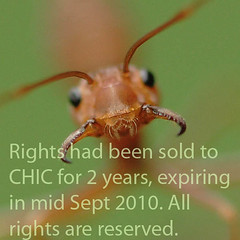
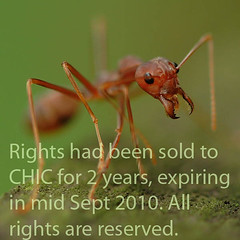
I had a lot of interactions with Weaver Ants. When I was too near them they started showing their warring stunt, getting even nearer, they started to open their pincers and snared at me. If I jerked my lens, they would move back abruptly but still ever ready to pick a fight. It is really thrilling to shoot Weaver Ants’ portraiture. They are ever reactive and evocative in their bodily expression.
Comfortable working distance
I started with the 100 mm Canon and later I bought the 60 mm Macro. Recently I bought the 35 mm Macro lens. After going through all the 3 different lenses and using that to shoot macros, I realized their pros and cons, apart from their optics characteristics such as sharpness and aberration, working distance is very important.
First I would consider ease of getting near the insect, the 100 mm does a better job as the distance between you and the insect is at a comfortable distance. The distance between the lens and the insect is further with the 100 mm then the 60 mm when you are at the 1:1 magnification but still within a distance where you could reach for subject. However your body and head will be further away from the insect as compared to the 60 mm. The 180 mm would be too far for you to have some form of interaction with the insects or spider. With the 180 mm you are always the remote observer, non-participatory. There is always this fear and inhibition when getting too near the insect, you will be cautious towards the unfamiliar, of course there would always be the few who are the dare devil. So for this first reason I would recommend the 100 mm for the starter.
Depth of Field
This is a very complicated subject. The control of depth of field is really, to me, more visual than scientific. Firstly, Depth of Field (DoF) depends on the focal length of the lens; the longer the lens the narrower the depth of field with other factors being constant. Secondly, DoF depends on the distance between the subject and the lens, the narrower this distance the shallower the DoF. Thirdly, the larger the aperture the shallower the DoF. Of course the one last factor is how perpendicular is the lens with the picture plane. This is why Lensbaby can create selective focus by titling the lens and the picture plane. As the 100mm is longer than the 60 mm, at the same distance and same aperture the image will have a shallow depth of field. However, the image magnification will not be the same. Hence if the magnification is the same it is really difficult to say for sure which have the shallow depth of field, as the degree of impact due to these reasons is difficult to quantify. I had not found a definite answer for the same magnification at the same aperture, which lens has a better depth of field. It could be possible that they are the same. Anyway, for me, I love bokeh and shallow depth of field as I am all for selective focusing and chasing after that portraiture of the minute world. Strangely I have this feeling that I get a deeper depth of field with the 100 mm lens. It is nothing scientific but just an observation. May be someone can tell me whether my feeling is accurate.
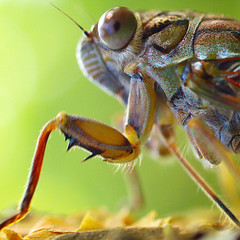
This was shot with the 35mm Macro mounted on the Limix G1
Compression of image
When the focal length of the lens is longer, the image appears more compressed. The perception of distance reduces and we tend to misconstrue that the subject is flatter or the distance between the subject and other body is nearer. Cinematographer heightens the danger of a car or alien chasing the earthlings has used this technique. The same happens to the photographing insects and spider. By using a wide angle lens we exaggerate the distance between the subject and us. So when deciding between the 100 mm, 60 mm or the 180 mm, this is major consideration as it determine a compressed or lengthen perspective. Recently, I shot a Cicada with the 35 mm lens; this effect was so obvious that, the Cicada was perceived to be so huge and grand. It made the Cicada so majestic and commanding. So this will depends on the preference of the photographer and his/her style.

This was shot with 60mm on Canon 400D
This aspect is very personal. Using Flickr is very handy to check the visual impact of wide angle macro or tele-macro. I would recommend that for Macro starters, this is not the most important factor to consider. The difficult of getting near the insect is a major factor. For starter, most have difficulty getting near insects. A longer lens would help, as one can stay further away to achieve maximum magnification.
Lens Size and Angle
As the lens’ focal length gets longer, the diameter of the lens barrel gets larger. For sample, the diameter of the macro lens of 180 mm is larger than the 100 mm and the 100 mm is larger than the 60 mm. What is the impact of a larger diameter barrel? It has to do with maneuverability. As the subject could be further away behind bushes, a longer lens barrel with large diameter could be block by branches.
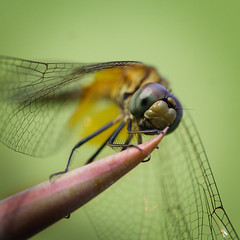
This was shot with the 100mm on 350D
For smaller barrel and reasonable length, it is easier to get good shot of the subject. For the 60 mm, the body is too close to the lens and to move it forward; the whole camera may need to go with the lens including the head of the photographer, if there is no live-view on the camera. The 100 mm could be better off but definitely it is worst for the 180 mm. For the reason of diameter of the barrel, I see the advantage of the Canon 100 mm macro over the Nikon 100 mm. With the anti-shake capability of the Nikon 100 mm the barrel bloated up.
Weight of the lens
I cannot speak for others, but I am definitely one of those who like to travel light and stick to a few fix focal length lens rather than buy up every single lens that is in the market just to collect them or every single zoom I had tried the 100 mm Nikon and the weight when compared to my Canon body plus the 100 mm is much heavier and one would feel the weight after half an hour into photographing the insects.
Anti-shake lens
One advantage of the Nikon Macro lens is the feature of anti-shake or VR (Vibration Reduction), it boast that it can improve hand held timing to lower shutter speed without noticeable blurriness in the photographs. However, I am no so sure about this feature, haven’t used a Nikon Macro lens myself. Some had argued fervently that for Macro photography, Anti-Stake does no improvement to the photograph.
Aperture
I had tried the 105 mm Nikkor and realized something strange. Whenever I get close to 1:1 magnification, the aperture reduces to smaller than f2.8. I am not so sure what happens, but I did read a web site confirming my observation and said the lens is a variable aperture lens.
Too Little Action
I can only conclude that if you were selecting between the 2 different lenses, it would be wise to test it out personally or do property peeping in Flickr to see the range of images they both had created. One can get a sense of the lens visual capability and uniqueness.
There will always be differences between different lenses and different brand of camera. All the technical comparison will have to stop somewhere and get on to photographing the micro-world, otherwise there is just too much talk and too little action.
What I did after shooting, was studying the images carefully, investigating the uniqueness of the images created by the camera and the lens. Different camera body with the same lens also performs differently and this is reflected in the image itself. However, the creation of artwork and that special artistic work style depends little on the equipment one uses, but one’s creativity and the acceptance of the audience. The best was to adhere to one’s believe and one’s vision, couple with relentless hard work and unceasing search for the limits of the vision.
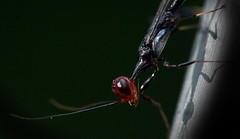
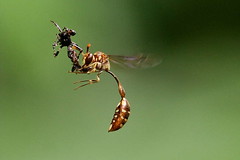





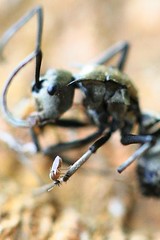

I did not understand, in the section “Compression of image”, why a 35mm lens would make the subject seem closer, compared with say, a 105mm macro lens. Could you kindly elaborate? Thanks!
Here is a long discussion on lens compression, distance and lens focal length,http://photo.net/digital-camera-shopping-forum/00GI2v
For me, with a wide-angle lens, by going nearer the subject, I get a wider perspective. With a long lens the minimum distance is still some inches away. I am practical as I just shoot and compare the image, if I need to create a wider perspective, I would know how the lens I have would performed. Nothing beats testing out.